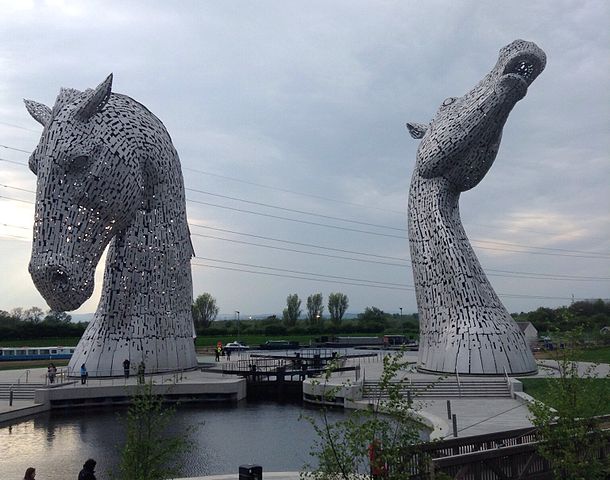The Kelpies
Kelpies are mythological shape-shifting spirits possessing the strength and endurance of 100 horses and inhabiting the lochs and pools of Scotland, where they usually appear as horses, but can adopt human form.
The Kelpies, are two 30 metre high stainless steel clad monuments at The Helix on the Forth and Clyde Canal. They were the vision of artist Andy Scott, and were inspired by the mythological beasts.
The Helix was established just outside Falkirk, between Edinburgh and Glasgow, in 2003, creating a green space to connect and engage the local communities.
The Kelpies represent the transformational and sustainable qualities of The Helix and recognise the historical reliance industry had on horses; pulling wagons, ploughs, barges and coal ships and helping transform the economy.
Scott said, "I see The Kelpies as a personification of local and national equine history, of the lost industries of Scotland. I also envisage them as a symbol of modern Scotland - proud and majestic, of the people and the land... They stand testament to the achievements of the past, a tribute to artisanship and engineering and a proud declaration of intent for the future of Scotland."
The Kelpies weigh 300 tonnes each and sit on 1,200 tonnes of steel-reinforced concrete foundations. They were built in just 90 days and were 'topped out' on 27 November 2013. They opened to the public on 21 April 2014 and were visited by nearly a million people in their first year.
A 30-minute guided walking tour takes visitors through Scott’s vision and explains the relationship of The Kelpies with history and industry. The tour culminates with access to the inside of a Kelpie to see the engineering supporting the structure.
Find out more
Related articles on Designing Buildings Wiki
Featured articles and news
Latest Build UK Building Safety Regime explainer published
Key elements in one short, now updated document.
UKGBC launch the UK Climate Resilience Roadmap
First guidance of its kind on direct climate impacts for the built environment and how it can adapt.
CLC Health, Safety and Wellbeing Strategy 2025
Launched by the Minister for Industry to look at fatalities on site, improving mental health and other issues.
One of the most impressive Victorian architects. Book review.
Common Assessment Standard now with building safety
New CAS update now includes mandatory building safety questions.
RTPI leader to become new CIOB Chief Executive Officer
Dr Victoria Hills MRTPI, FICE to take over after Caroline Gumble’s departure.
Social and affordable housing, a long term plan for delivery
The “Delivering a Decade of Renewal for Social and Affordable Housing” strategy sets out future path.
A change to adoptive architecture
Effects of global weather warming on architectural detailing, material choice and human interaction.
The proposed publicly owned and backed subsidiary of Homes England, to facilitate new homes.
How big is the problem and what can we do to mitigate the effects?
Overheating guidance and tools for building designers
A number of cool guides to help with the heat.
The UK's Modern Industrial Strategy: A 10 year plan
Previous consultation criticism, current key elements and general support with some persisting reservations.
Building Safety Regulator reforms
New roles, new staff and a new fast track service pave the way for a single construction regulator.
Architectural Technologist CPDs and Communications
CIAT CPD… and how you can do it!
Cooling centres and cool spaces
Managing extreme heat in cities by directing the public to places for heat stress relief and water sources.
Winter gardens: A brief history and warm variations
Extending the season with glass in different forms and terms.
Restoring Great Yarmouth's Winter Gardens
Transforming one of the least sustainable constructions imaginable.























